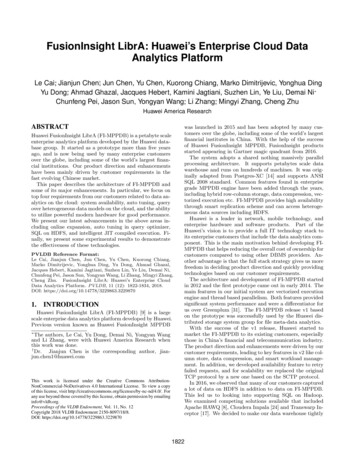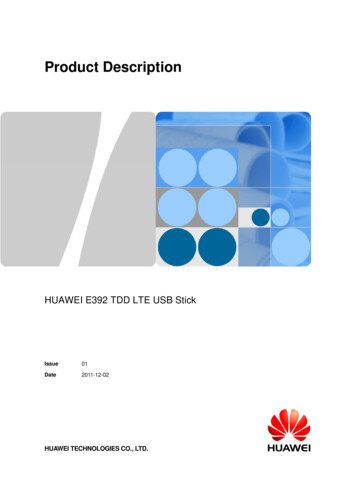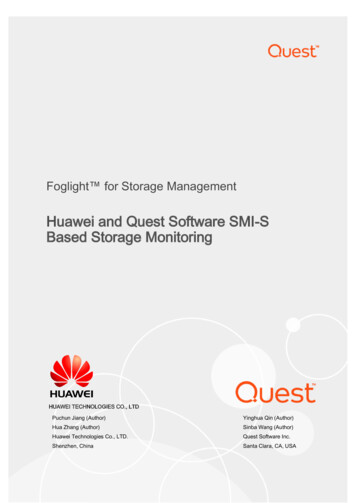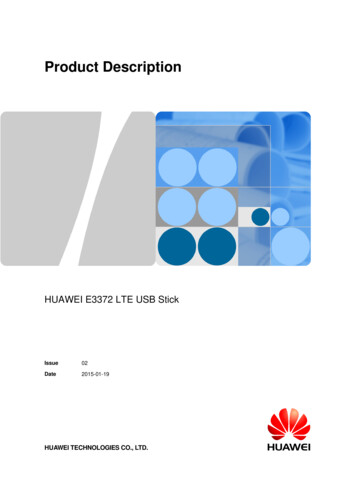
Transcription
FusionInsight LibrA: Huawei’s Enterprise Cloud DataAnalytics PlatformLe Cai , Jianjun Chen†, Jun Chen, Yu Chen, Kuorong Chiang, Marko Dimitrijevic, Yonghua DingYu Dong , Ahmad Ghazal, Jacques Hebert, Kamini Jagtiani, Suzhen Lin, Ye Liu, Demai Ni Chunfeng Pei, Jason Sun, Yongyan Wang , Li Zhang , Mingyi Zhang, Cheng ZhuHuawei America ResearchABSTRACTHuawei FusionInsight LibrA (FI-MPPDB) is a petabyte scaleenterprise analytics platform developed by the Huawei database group. It started as a prototype more than five yearsago, and is now being used by many enterprise customersover the globe, including some of the world’s largest financial institutions. Our product direction and enhancementshave been mainly driven by customer requirements in thefast evolving Chinese market.This paper describes the architecture of FI-MPPDB andsome of its major enhancements. In particular, we focus ontop four requirements from our customers related to data analytics on the cloud: system availability, auto tuning, queryover heterogeneous data models on the cloud, and the abilityto utilize powerful modern hardware for good performance.We present our latest advancements in the above areas including online expansion, auto tuning in query optimizer,SQL on HDFS, and intelligent JIT compiled execution. Finally, we present some experimental results to demonstratethe effectiveness of these technologies.PVLDB Reference Format:Le Cai, Jianjun Chen, Jun Chen, Yu Chen, Kuorong Chiang,Marko Dimitrijevic, Yonghua Ding, Yu Dong, Ahmad Ghazal,Jacques Hebert, Kamini Jagtiani, Suzhen Lin, Ye Liu, Demai Ni,Chunfeng Pei, Jason Sun, Yongyan Wang, Li Zhang, Mingyi Zhang,Cheng Zhu. FusionInsight LibrA: Huawei’s Enterprise CloudData Analytics Platform. PVLDB, 11 (12): 1822-1834, 2018.DOI: TIONHuawei FusionInsight LibrA (FI-MPPDB) [9] is a largescale enterprise data analytics platform developed by Huawei.Previous version known as Huawei FusionInsight MPPDB The authors, Le Cai, Yu Dong, Demai Ni, Yongyan Wangand Li Zhang, were with Huawei America Research whenthis work was done.†Dr. Jianjun Chen is the corresponding author, jianjun.chen1@huawei.comThis work is licensed under the Creative Commons AttributionNonCommercial-NoDerivatives 4.0 International License. To view a copyof this license, visit http://creativecommons.org/licenses/by-nc-nd/4.0/. Forany use beyond those covered by this license, obtain permission by emailinginfo@vldb.org.Proceedings of the VLDB Endowment, Vol. 11, No. 12Copyright 2018 VLDB Endowment 2150-8097/18/8.DOI: https://doi.org/10.14778/3229863.3229870was launched in 2015 and has been adopted by many customers over the globe, including some of the world’s largestfinancial institutes in China. With the help of the successof Huawei FusionInsight MPPDB, FusionInsight productsstarted appearing in Gartner magic quadrant from 2016.The system adopts a shared nothing massively parallelprocessing architecture. It supports petabytes scale datawarehouse and runs on hundreds of machines. It was originally adapted from Postgres-XC [14] and supports ANSISQL 2008 standard. Common features found in enterprisegrade MPPDB engine have been added through the years,including hybrid row-column storage, data compression, vectorized execution etc. FI-MPPDB provides high availabilitythrough smart replication scheme and can access heterogeneous data sources including HDFS.Huawei is a leader in network, mobile technology, andenterprise hardware and software products. Part of theHuawei’s vision is to provide a full IT technology stack toits enterprise customers that include the data analytics component. This is the main motivation behind developing FIMPPDB that helps reducing the overall cost of ownership forcustomers compared to using other DBMS providers. Another advantage is that the full stack strategy gives us morefreedom in deciding product direction and quickly providingtechnologies based on our customer requirements.The architecture and development of FI-MPPDB startedin 2012 and the first prototype came out in early 2014. Themain features in our initial system are vectorized executionengine and thread based parallelism. Both features providedsignificant system performance and were a differentiator forus over Greenplum [31]. The FI-MPPDB release v1 basedon the prototype was successfully used by the Huawei distributed storage system group for file meta-data analytics.With the success of the v1 release, Huawei started tomarket the FI-MPPDB to its existing customers, especiallythose in China’s financial and telecommunication industry.The product direction and enhancements were driven by ourcustomer requirements, leading to key features in v2 like column store, data compression, and smart workload management. In addition, we developed availability feature to retryfailed requests, and for scalability we replaced the originalTCP protocol by a new one based on the SCTP protocol.In 2016, we observed that many of our customers captureda lot of data on HDFS in addition to data on FI-MPPDB.This led us to looking into supporting SQL on Hadoop.We examined competing solutions available that includedApache HAWQ [8], Cloudera Impala [24] and Transwarp Inceptor [17]. We decided to make our data warehouse tightly1822
integrated with HDFS, allowing our MPP engine to directlywork on HDFS data and avoid data movement from HDFSto the FI-MPPDB storage. This approach provides a seamless solution between MPPDB and HDFS with better SQLperformance than Transwarp Inceptor, and stronger ACIDsupport than Cloudera Impala. The HDFS support wasadded to the FI-MPPDB in 2016 and successfully adoptedby many of our customers. As a result, FI-MPPDB becamepart of Huawei FusionInsight product in 2016.In 2017, we announced our first version of FI-MPPDB onHuawei public cloud, a.k.a. LibrA. Based on our customers’feedbacks on our cloud offering, the top requirements are 1)system availability, 2) auto tuning, 3) support querying largeand diversified data models on the cloud, and 4) best utilizemodern hardware for achieving high performance over costratio.First, system availability requires that FI-MPPDB shouldbe able to add more nodes (elasticity) or go through an upgrade with minimal impact on customer workloads. Thisis critical for large systems with petabytes of data that cantake hours or even days to migrate and re-balance duringsystem expansion. Similarly, system upgrade can also takehours to finish and make the system unavailable for theend user. These requirements are addressed by our recentfeatures online expansion and online upgrade which greatlyminimize the impact of system expansion and software upgrades. Due to the space limitation, we will only cover onlineexpansion in this paper.Second, DBMS auto tuning minimizes the need for manual tuning by system DBAs. For cloud deployment, suchtuning can be complex and costly with the elasticity of thesystem and the access to heterogeneous data sources. Autonomous database from Oracle [13] emphasizes self managing and auto tuning capabilities, an indication that cloudproviders are paying great attention to this area. We havebeen working on automatic query performance tuning throughruntime feedbacks augmented by machine learning.Third, our cloud customers now have huge amount of datain various formats stored in Huawei cloud storage systems,which are similar to S3 and EBS in AWS. Recently, thenotion of Data Lake becomes popular which allows data residing inside cloud storage to be directly queried withoutthe need to move them into data warehouse through ETL.AWS Spectrum [3] and Athena [1] are recent products thatprovide this functionality. Our product provides SQL onHadoop (SQLonHadoop) support (a.k.a. ELK in FusionInsight) which was successfully used by many of our customers.Fourth, modern computer systems have increasingly largermain memory, allowing the working set of modern databasemanagement systems to reside in the main memory. Withthe adoption of fast IO devices such as SSD, slow disk accesses are largely avoided. Therefore, the CPU cost of queryexecution becomes more critical in modern database systems. The demand from cloud database customers on highperformance/cost ratio requires us to fully utilize the greatpower provided by modern hardware. An attractive approach for fast query processing is just-in-time (JIT) compilation of incoming queries in the database execution engine.By producing query-specific machine code at runtime, theoverhead of traditional interpretation can be reduced. Theeffectiveness of JIT compiled query execution also dependson the trade-off between the cost of JIT compilation andthe performance gain from the compiled code. We will in-Figure 1: FusionInsight MPPDB System High-levelArchitecturetroduce our cost based approach in JIT compilation in thispaper.The rest of this paper is organized as follows. Section2 presents an overview of the FI-MPPDB architecture followed by the technical description of the four major directions discussed above. Our experimental results are presented in section 3, which show the efficiency of our onlineexpansion solution, the benefit of auto tuning, the effectiveness of the co-location strategy of SQLonHDFS, and the performance gain from the JIT generated code. Related work isdiscussed in Section 4 which compares our approaches withother industry leaders in the four cloud key areas. Finally,we conclude our paper in section 5 and discuss future work.2.TECHNICAL DETAILSIn this section, we first give an overview of FI-MPPDB,and then we present our solutions to the four top customerrequirements described in section 1.2.1System OverviewFI-MPPDB is designed to scale linearly to hundreds ofphysical machines and to handle a wide spectrum of interactive analytics. Figure 1 illustrates the high level logical system architecture. Database data are partitioned and storedin many data nodes which fulfill local ACID properties.Cross-partition consistency is maintained by using two phasecommit and global transaction management. FI-MPPDBsupports both row and columnar storage formats. Our vectorized execution engine is equipped with latest SIMD instructions for fine-grained parallelism. Query planning andexecution are optimized for large scale parallel processingacross hundreds of servers. They exchange data on-demandfrom each other and execute the query in parallel.Our innovative distributed transaction management (GTMlite) distinguishes transactions accessing data of a singlepartition from those of multiple partitions. Single-partitiontransactions get speed-up by avoiding acquiring centralizedtransaction ID and global snapshot. GTM-lite supportsREAD COMMITTED isolation level and can scale out FIMPPDB’s throughput manifold for single-partition heavyworkloads.2.1.1CommunicationUsing TCP protocol, the data communication requires ahuge number of concurrent network connections. The maximum concurrent connections will increase very quickly withlarger clusters, higher numbers of concurrent queries, and1823
more complex queries requiring data exchange. For example, the number of concurrent connections on one physicalhost can easily go up to the scale of one million given acluster of 1000 data nodes, 100 concurrent queries, and anaverage of 10 data exchange operators per query (1000 *100 * 10 1,000,000). To overcome this challenge, we designed a unique communication service infrastructure whereeach data exchange communication pair between a consumerand a producer is considered a virtual or logical connection.Logical connections between a given pair of nodes share onephysical connection. By virtualizing the data exchange connections with shared physical connections, the total numberof physical connections on a physical host system is significantly reduced. We chose SCTP (Stream Control Transmission Protocol) as the transport layer protocol to leverage itsbuilt-in stream mechanism. SCTP offers reliable messagebased transportation and allows up to 65535 streams toshare one SCTP connection. In addition, SCTP can support out-of-band flow control with better behavior controland fairness. All those features match the requirements ofour design of logical connections and simplify the implementation compared to the customized multiplexing mechanism.2.1.2High Availability and ReplicationIt is always a challenge to achieve high availability ofdatabase service across a large scale server fleet. Such system may encounter hardware failures so as to considerablyimpact service availability. FI-MPPDB utilizes primarysecondary model and synchronous replication. The amountof data stored in data warehouses are normally huge, up tohundreds of TB or even PB, so saving storage usage is a critical way to lower overall cost. A data copy is stored in primary and secondary data nodes, respectively. In addition,a dummy data node maintains a log-only copy to increaseavailability when secondary data nodes fail. Introducingthe dummy data node solves two problems in synchronousreplication and secondary data node catch-up. First, whensecondary data nodes crash, primary data nodes can execute bulkload or DML operations because log can still besynchronously replicated to the dummy data nodes. Second, after recovering from crash, secondary data nodes needto catch up with primary data nodes for those updates happening when secondary data nodes are down. However, theprimary data nodes may have already truncated log, causingsecondary data nodes’ recovery and catch-up to fail. This issolved by dummy data nodes providing the needed log.2.1.3Workload ManagementThe performance of analytical query processing is oftensensitive to available system resources. FI-MPPDB dependson a workload manager to control the number of concurrently running queries. The workload manager optimizessystem throughput while avoiding the slow-down caused byqueries competing for system resources.The workload manager consists of three main components:resource pools, workload groups, and a controller. Resourcepools are used for allocating shared system resources, suchas memory and disk I/O, to queries running in the system,and for setting various execution thresholds that determinehow the queries are allowed to execute. All queries run in aresource pool, and the workload group is used for assigningthe arriving queries to a resource pool. Workload groups areused to identify arriving queries through the source of thequeries such as its application name. The controller evaluates queries and dynamically makes decisions on executionbased on the query’s resource demands (i.e., costs) and thesystem’s available resources (i.e., capacity). A query startsexecuting if its estimated cost is not greater than the system’s available capacity. Otherwise, the query is queued.Resource bookkeeping and feedback mechanisms are usedin keeping tracking of the system’s available capacity. Thequeued queries are de-queued and sent to the execution engine when the system’s capacity becomes sufficient.2.2Online ExpansionModern massively parallel processing database management systems (MPPDB) scale out by partitioning and distributing data to servers and running individual transactionsin parallel. MPPDB can enlarge its storage and computation capacity by adding more servers. One of the importantproblems in such scale-out operation is how to distributedata to newly added servers. Typically, the distributionapproach uses certain algorithms (such as hash functions,modulo, or round-robin) to compute a value from one column (called distribution column in a table). This value isused to determine which server (or database instance) storesthe corresponding record. The result of those algorithms depends on the number of servers (or database instances) inthe cluster. Adding new servers makes those algorithms invalid. A data re-distribution based on the number of servers,including newly added ones, is needed to restore the consistency between distribution algorithms’ result and the actuallocation of records. In addition, hash distribution may besubjected to data skew where one or more servers are assigned significantly more data, causing them to run out ofspace or computing resource. In such cases, one can choose adifferent hashing function, re-compute the distribution map,and move data around to eliminate the skew and balance theload.2.2.1Solution OverviewA naive implementation of redistribution is to take the table offline, reorganize the data in place, and move relevantdata to newly added nodes. During this process, the tablecannot be accessed. Alternatively, one can create a shadowtable and load it with the data while keeping the original table open for query. But until the data is redistributed to thenew nodes, the distribution property does not hold amongthe new set of nodes. In order to make the table availablefor query during the redistribution process, one choice is tochange table distribution property from hash to random asdone in Greenplum [20]. Such an approach allows the datato be queried, but the query performance is degraded sincedata locality information is lost and collocated joins are notpossible. In addition, data modification operations (such asIUD) are blocked on the table during redistribution, causinginterruption to user workloads for extended period of time.For our solution, we use the shadow table approach for redistribution. But instead of making the table read-only, wemodify the storage property of the original table to appendonly mode and prevent the recycling of the storage space.This gives us an easy way to identify the new records addedto the table (called append-delta) during data redistribution. Additionally we create a temporary table to store thekeys (rowid) of deleted records (called delete-delta). Afterthe existing data has been redistributed, we lock down the1824
table, reapply the append-delta, and then delete-delta onthe shadow table. To facilitate the application of deletedelta, the shadow table is created with additional columnthat stores the rowid from the original table. This way wecan join the shadow table with delete-delta table to applythe delete-delta.Our approach offers the following advantages Our solution allows DML operations including insert,delete, and update while the table is being redistributed. Our method of redistribution of a table can be configured to progress in small batches. Each batch canbe done quickly to minimize load increase to the system. Each unit is done as a transaction and the wholeredistribution can be suspended and resumed betweentables. Our method requires only one scan of data in the original table for the redistribution. This improves theoverall redistribution performance. The only additional scan of data is done on the shadow table whendelete-delta is being applied. Our method can also be used for cluster downsizingwithout any changes. In both cases, extra space oneach member of the new cluster is needed to store thetemporary shadow table. The total size of the temporary shadow table is the same as the size of the originaltable.2.2.2Core AlgorithmAlgorithm 1 illustrates the algorithm to execute the redistribution while still allowing normal DML operation on thetable.Algorithm 1 Algorithm Redistribution DML1: Create a shadow table S with the same schema as theoriginal table T to be redistributed2: Mark T as append only3: Disable garbage collection on T4: Create a delete-delta table D for deletes on T5: Redistribute a segment of T into S.6: Apply D on S and reset D when finished.7: Commit the change.8: Repeat steps 5-7 until the remaining records in T issmaller than a threshold9: Lock the original table. Redistribute the remaining insert and delete delta, just as in step 5 and 6.10: Switch the T with S in the catalog.11: Commit the changes.12: Rebuild indexesIn Algorithm 1, steps 1 through 4 prepare the table T forredistribution. In step 1, we create a shadow table S with thesame schema as T plus a hidden column (original tuple key)to store the original tuple key of records moved from T. Indexes on S are disabled during this phase until all redistribution is done. In step 2, we mark T as append-only anddisable reuse of its freed space. With this conversion, insertsto T will be appended to the end of T, deletions are handledby marking the deleted record, and updates on the T are internally converted to deletions followed by inserts. In step3, we disable the garbage collection on T to keep recordsFigure 2: Example of Redistribution Phasesof its original position during the data redistribution process. In step 4, a temporary table delete-delta D is createdto keep track of the original tuple keys of deleted records.Since the space in the original table is not reused after theredistribution has begun, the tuple key can uniquely identify a version of a record, allowing us to apply the deletionsin the new table later on.In steps 5 through 7 we start rounds of redistribution ofrecords from T, one segment at a time. In step 5, we get asnapshot and start to scan a segment of the table, move allvisible records to S, distribute them into a new set of nodesaccording to the new distribution property (new node groupand/or new hash function), and record the unique originaltuple key from the original table in the hidden column of thenew table (explained in step one). In step 6, we apply thedeletion in this segment happened during the redistributionof the segment by deleting the records in the new table using the original-tuple-key stored in D. D is reset after it isapplied and this phase is committed in step 7.In step 8, we iterate over steps 5 through 7 until the remaining data in T is small enough (based on some systemthreshold). Step 9 starts the last phase of the redistribution by locking T, redistributing the remaining data in Tthe same way as steps 5-6. This is followed by renamingthe new table S to the original table T in step 10. Step 11commits the changes. Finally, we rebuild the indexes on Tin step 12.Figure 2 illustrates the redistribution process from step 59 using an example with 3 iterations. In this example, T1 isthe original table, and T1 tmp is the shadow table with thesame schema as T1. All three iterations apply both insertand delete delta changes introduced by Insert, Update andDelete (IUD) operations of T1 onto T1 tmp while still takingIUDs requests against T1. The last iteration which has smallset of delta changes locks on both tables exclusively in a briefmoment to redistribute the remaining insert and delete deltaas described in step 9.2.3Auto Tuning in Query OptimizerOur MPPDB optimizer is based on Postgresql optimizerwith fundamental enhancements to support complex OLAPworkloads. We briefly describe the main architectural changesin our optimizer. First, our optimizer is re-engineered tobe MPP aware that can build MPP plans and apply costbased optimizations that account for the cost of data exchange. Second, the optimizer is generalized to support1825
Figure 3: Statistics Learning Architectureplanning and cost based optimizations for vector executionsand multiple file systems including Apache ORC file format.Query rewrite is another major ongoing enhancement toour optimizer, including establishing a query rewrite engineand adding additional rewrites which are critical to complexOLAP queries.The enhancements mentioned above are common in othercommercial database and big data platforms. We believethat we are closing the gap with those established products. In addition, we are working on cutting edge technologybased on learning to make our optimizer more competitive.Our initial vision of a learning optimizer is in the area of cardinality estimation (statistics), which is one of the core components of cost based optimization. Traditional and classical methods of statistics used for cost based optimizationsare complex, require large capital investment, and evolvethrough time. Different sources of data with their different formats pose additional challenges to collecting statisticswith reasonable accuracy.Based on the above challenges in the optimizer statisticsarea, we are developing a learning component in the DBMSthat selectively captures actual execution statistics. Thecaptured data in turn can be used by the optimizer for moreaccurate statistics estimates for subsequent similar queries.Our experience shows that most OLAP workloads are focused on specific queries/reports and therefore the approachof capturing execution plans and re-using them is promisingand expected to mitigate the optimizer statistics limitations.This approach is also appealing, given that its engineeringcost is much less than the traditional methods of collectingand using optimizer statistics, which it took decades to develop for the big players of OLAP and data warehousing,such as IBM DB2, Oracle and Teradata.Figure 3 is a high level illustration of our statistics learningapproach. The new architecture has two sub-components:capturing execution plans and re-using them by the optimizer. Based on user settings/directives, the execution engine (executor) selectively captures execution plan into aplan store. The plan store schema is modeled after the planexecution steps. Each step (scan, join, aggregation, etc)is captured with the estimated and actual row counts. Tomake the store more efficient and useful, the executor captures only those steps that have a big differential betweenactual and estimated row counts. A related but differentstore is general MPPDB plan store which is more detailedand used for auditing and off-line analysis.The optimizer gets statistics information from the planstore and uses it instead of its own estimates. This is doneefficiently through an API call to the plan store which ismodeled as a cache. The key of the cache is encoded basedon different steps description that includes step type, steppredicate (if any), and input description. Obviously, the useof steps statistics is done opportunistically by the optimizer.If no relevant information can be found at the plan store,the optimizer proceeds with its own estimates. Our initialproof of concept for statistics learning is done for scan andjoin steps. We call this approach selectivity matching.In addition to exact matches with previously stored predicates, auto tuning can be applied to similar predicates aswell. We can gather predicate selectivity feedbacks in aspecial cache (separate from the plan store cache describedabove) and use it to estimate selectivity for similar conditions. Many machine or statistical learning algorithms canbe used for this purpose. We call this second learning technique similarity selectivity and we also call this special caseas predicate cache.Our similarity selectivity model is initially applied to complex predicate like x y c where both x and y are columnsand c is a constant. Such complex predicates are commonwith date fields. For example, some of the TPC-H queries involve predicates like l receiptdate l commitdate c whichrestricts line items that were received late by c days. Thesepredicates pose a challenge to query optimizers and they aregood candidates for our similarity selectivity. The more general form of these predicates is x y c1 and x y c2.For example, P 1 l receiptdate l commitdate 10 andl receiptdate l commitdate 20 retrieves all line itemsthat are between 10 and 20 days late.We choose KNN (K Nearest Neighbors) as the approachfor our similarity selectivity. The selectivity of a new predicate is estimated to be the average selectivity of its K nearestneighbors in the predicate cache. The rationale here is thatevents close to each other have similar properties. For example, late line items tend to be fewer and fewer as the difference between the receipt date and commit date gets bigger.The distance metric used by KNN is simply the Euclideandistance based on c1 and c2. For example, the distance between P 1 above and P 2 l receiptdate l commitdateand l receiptdate l commitdate 15 is computed asthe Euclidean distance between the two points (10,20) and(0,15).2.4MPPDB over HDFS (aka SQLonHDFS)As big data platform and cloud become popular in recent years, many of our customers store huge amount ofsemi-structured and nonstructural data in Hadoop HDFS[11] in addition to storing their structured data in MPPDB.Hadoop HDFS is capable of scaling to petabytes of data andis steadily improving its performance and availability. Onesignificant customer requirement is to be able to query dataacross heterogeneous data storage systems including HDFS.In this section, we discuss how our system addresses suchneeds.2.4.1SQLonHDFS using Foreign Data WrapperFI-MPPDB first adopted the HDFS as an external datasource through PostgreSQL’s Foreign Data Wrapper (FDW).We introduced a Scheduler component to bypass HadoopMap-Reduce framework, and dynamically assigned splits ofdata files to MPP data nodes for efficient processing andload balancing. Similar architecture can be found on otheropen source SQLonHDFS solutions such as HAWQ [8] andImpala [24]. Figure 4 illustrates the flow of FI-MPPDBquery processing:1826
In the following sections, we will discuss our recent improvements in these areas.2.4.2Advanced Data Collocation and Hash PartitioningHDFS doesn’t support data collocation through consistent hashing algorithm which is a performance enhancementtechnique widely adopted in commercial MPPDB systemsincluding FI-MPPDB. This means standard database operations such as JOIN, GROUP BY, etc will often requireextra data shuffling among the clusters when performed onHDFS storage.There are two kinds of data collocation schemes we considered:1. Data collocation between MPPDB data nodes and HDFSdata nodes: this allows MPP data nodes to scan datain HDFS through short-circuit local read interface wherehigher scan speed can be achieved.Figure 4: MPPDB Foreign HDFS Data Architecture2. Table collocations
Huawei public cloud, a.k.a. LibrA. Based on our customers' feedbacks on our cloud o ering, the top requirements are 1) system availability, 2) auto tuning, 3) support querying large and diversi ed data models on the cloud, and 4) best utilize modern hardware for achieving high performance over cost ratio.










